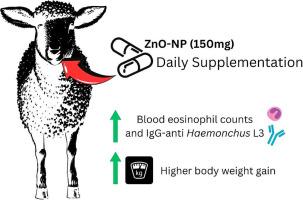Effects of zinc oxide nanoparticle supplementation in young sheep naturally infected with gastrointestinal nematodes
IF 1.4
Q3 PARASITOLOGY
Veterinary parasitology, regional studies and reports
Pub Date : 2025-09-01
DOI:10.1016/j.vprsr.2025.101340
引用次数: 0
Abstract
The experiment aimed to evaluate the effects of daily supplementation with 150 mg of ZnO-NP on performance, hematological and immunological responses of lambs naturally infected with GIN under grazing conditions. Given the field-based approach adopted, the study was designed as an exploratory trial to generate preliminary evidence and hypotheses for future controlled experiments, acknowledging that individual feed intake was not measured and, therefore, the effect of ZnO-NP cannot be fully isolated from variations in voluntary concentrate intake. Each animal of one group (n = 14) was daily supplemented for 127 days with a capsule containing 150 mg of ZnO-NP in powder (40 nm), while a control group (n = 13) was kept without receiving Zn supplementation. Animals supplemented with Zn showed higher PCV and TPP values in the most critical period of infection, around day 70 of the trial, indicating increased resilience against GIN infections. Precisely during this period, animals that received Zn showed the highest values of blood eosinophils and Immunoglobulin G (IgG)-anti-Haemonchus. There was a tendency for a difference between groups in mean total body weight gain (P = 0.06), where the group supplemented with zinc oxide obtained the highest means. In conclusion, daily supplementation with 150 mg of ZnO-NP was associated with increased eosinophil counts and a tendency toward greater body weight gain in young sheep naturally infected with GIN.

补充氧化锌纳米颗粒对自然感染胃肠道线虫的幼羊的影响
本试验旨在评价放牧条件下每日添加150 mg ZnO-NP对自然感染GIN羔羊生产性能、血液学和免疫反应的影响。考虑到采用了基于现场的方法,该研究被设计为一项探索性试验,为未来的对照实验提供初步证据和假设,承认没有测量个体采食量,因此,ZnO-NP的影响不能完全与自愿精料摄入量的变化分离。其中一组(n = 14)每天补锌150 mg (40 nm),连续127 d;对照组(n = 13)不补锌。在感染的最关键时期,即试验第70天左右,添加Zn的动物显示出更高的PCV和TPP值,表明对GIN感染的抵抗力增强。正是在这一时期,接受锌治疗的动物显示出最高的血嗜酸性粒细胞和免疫球蛋白G (IgG)-抗haemonchus。各组之间的平均总体重增加有差异的趋势(P = 0.06),其中添加氧化锌组的平均体重增加最高。综上所述,每日添加150 mg ZnO-NP与自然感染GIN的幼羊嗜酸性粒细胞计数增加和体重增加趋势有关。
本文章由计算机程序翻译,如有差异,请以英文原文为准。
求助全文
约1分钟内获得全文
求助全文
来源期刊
CiteScore
2.90
自引率
7.10%
发文量
126
审稿时长
97 days
期刊介绍:
Veterinary Parasitology: Regional Studies and Reports focuses on aspects of veterinary parasitology that are of regional concern, which is especially important in this era of climate change and the rapid and often unconstrained travel of people and animals. Relative to regions, this journal will accept papers of the highest quality dealing with all aspects of disease prevention, pathology, treatment, epidemiology, and control of parasites within the field of veterinary medicine. Also, case reports will be considered as they add to information related to local disease and its control; such papers must be concise and represent appropriate medical intervention. Papers on veterinary parasitology from wildlife species are acceptable, but only if they relate to the practice of veterinary medicine. Studies on vector-borne bacterial and viral agents are suitable, but only if the paper deals with vector transmission of these organisms to domesticated animals. Studies dealing with parasite control by means of natural products, both in vivo and in vitro, are more suited for one of the many journals that now specialize in papers of this type. However, due to the regional nature of much of this research, submissions may be considered based upon a case being made by the author(s) to the Editor. Circumstances relating to animal experimentation must meet the International Guiding Principles for Biomedical Research Involving Animals as issued by the Council for International Organizations of Medical Sciences (obtainable from: Executive Secretary C.I.O.M.S., c/o W.H.O., Via Appia, CH-1211 Geneva 27, Switzerland).

 求助内容:
求助内容: 应助结果提醒方式:
应助结果提醒方式:


